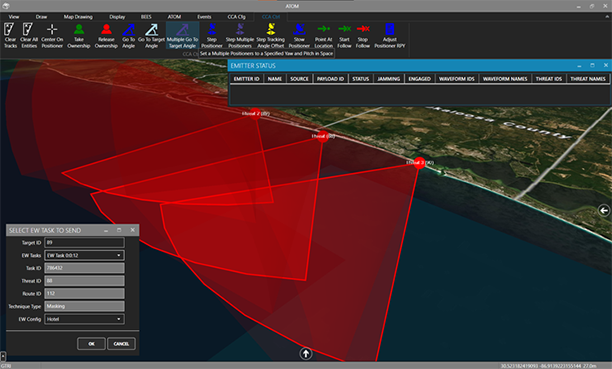
The electromagnetic spectrum is becoming more and more crowded as technological advancements have facilitated increasingly complex usage of radio frequencies across all technology sectors. This increased reliance on spectrum is especially relevant for military operations where it is vital infrastructure for accomplishing mission objectives. While electronic warfare has a long history, the ubiquity of electromagnetic spectrum usage in all parts of the battlefield now requires new tools and capabilities.
Intelligence, surveillance and reconnaissance (ISR), radar, communication, navigation, and command and control (C2) systems all require spectrum for functionality. Ensuring the functionality of these activities in a contested environment requires an unprecedented ability to ingest, process, and understand data from multiple, distributed, and heterogeneous sources.

Researchers at the Georgia Tech Research Institute (GTRI) are developing and testing new capabilities to address this challenge. The Electromagnetic Battle Management (EMBM) for Distributed Electronic Warfare Program will explore and develop technology to dynamically monitor, sense, and act upon the electromagnetic spectrum using networked and distributed radio frequency (RF) systems.
“We are trying to bring an understanding to what’s happening inside a complex electromagnetic environment,” said Breneman Whitfield, a GTRI senior research engineer who is leading the EMBM project. “We are initially looking at the electronic warfare (EW) aspect of the larger electromagnetic domain and using GTRI Angry Kitten EW systems to perform autonomous, collaborative, netted, distributed, electronic support to support the development of data processing, machine learning, and visualization techniques to provide decision aids.”
The program, funded by GTRI’s independent research and development initiative, is creating and demonstrating a technology baseline for the dynamic visualization and control of coordinated, spatially-distributed EW systems in complex, agile, and unpredictable electromagnetic signal environments.
Through this program, GTRI expects to provide an improved operating picture of the electromagnetic environment and machine-learning-based decision aids to guide the autonomous activities of distributed electromagnetic sensors and effectors. The ability to visualize and control electromagnetic sensing and electronic warfare activities performed by a coordinated team of spatially distributed systems could ultimately allow more efficient and effective spectrum usage.
The bottom line is helping make sense of all the data produced by devices in the electromagnetic battlespace and how to use the data to effectively make decisions.
“Individual systems and the employment of systems are rapidly becoming more complex,” Whitfield said. “We have to learn how to appropriately use the data and present it in a meaningful way. That is just going to become more challenging as the battlefield gets more complicated.”
Allocating spectrum appropriately among the many users in a contested battlefield is one of the key challenges ahead.
“The commercial and military need for electromagnetic spectrum is insatiable, and we are entering a new era where spectrum co-existence is paramount,” said William Melvin, deputy director of GTRI’s Sensors & Intelligent Systems Directorate. “The electromagnetic spectrum should be viewed as a domain in its own right, just like air, space, sea, ground, and cyber. It is the one domain that inextricably ties the other domains together. As a precious resource, monitoring and managing spectrum use is more critical now than ever before.”
GTRI began development by assembling a software integration environment using the “Low-Cost Kitten” variant of the Angry Kitten EW architecture family, based on commercially available software-defined radios and other commercially available components, to mimic a limited electromagnetic environment. This will be used for the research and development of algorithms and software to pursue the program objectives.
Some of these capabilities are already being brought to the field to aid in development, and a subset of capabilities was taken to a recent Air Force operational environment for testing and characterization.
Writer: John Toon
GTRI Communications
Georgia Tech Research Institute
Atlanta, Georgia USA
![]()
RETURN TO 2021 ANNUAL REPORT HOME
The Georgia Tech Research Institute (GTRI) is the nonprofit, applied research division of the Georgia Institute of Technology (Georgia Tech). Founded in 1934 as the Engineering Experiment Station, GTRI has grown to more than 2,800 employees supporting eight laboratories in over 20 locations around the country and performing more than $700 million of problem-solving research annually for government and industry. GTRI's renowned researchers combine science, engineering, economics, policy, and technical expertise to solve complex problems for the U.S. federal government, state, and industry.
Learn more at www.gtri.gatech.edu and follow us on LinkedIn, Twitter, Facebook, and Instagram.





